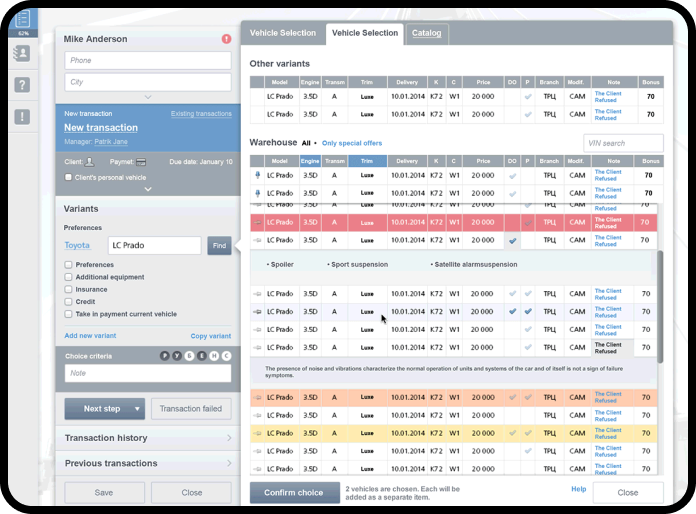Custom web development services
Using best IT innovations, we develop custom web and mobile applications that increase our customers’ competitive advantage and improve their business efficiency.
Why make custom web apps with SumatoSoft?
Our team, comprising 70% senior web developers, brings extensive experience to businesses on all continents. We select our web technology stack with a deep understanding of business needs, focusing on scalability and the resources required for maintaining future products.
30% less time to market with custom web development
25% reduction in project overhead through web consulting
90% success in reviving stalled projects through rescue missions
Custom web application development services
R&D & Analysis
Our R&D and business analyst team study your business and ideas in detail to help you reduce market and technical risks across the entire web app development:

UX/UI design
We follow a thorough web design approach focused on the way people interact with websites to ensure the interfaces are not only user-friendly but also focused on targeted action.

Frontend & Backend development
Our frontend and backend web developers have worked on and successfully delivered custom web applications of different complexity.

QA & Testing
Our QA pros join the web development team from day one to build a professional and holistic approach to Quality Assurance and make sure that the website works perfectly across all devices, browsers, screens, at any load and environment.

IT staff augmentation
Our specialists are ready to join your internal team on a contractual basis and help with custom web application development. If the expertise of your internal team isn’t enough to develop the web app or project, we can handle these issues.

Web applications we develop
We build high-performance, interactive, and user-friendly web applications that help companies streamline operations, improve customer experiences, and scale their businesses. SumatoSoft delivers solutions tailored to each Client’s needs, ensuring efficiency, security, and long-term success.
Enterprise web apps
Development of enterprise apps, including complex ERP, CRM, HRM, automated billing and payment systems etc.
MVPs for startups
Helping startups and small businesses to make prototypes and Minimum Viable Products ready to enter the market.
Internet of Things solutions
Building IoT web applications for data gathering, analyzing, and sharing. We make predictive decision-making possible.
SaaS product development
Designing custom SaaS products for companies, enabling them to shift activities to the cloud, integrate, and reduce costs.
Super apps
We provide development and consulting services for building all-in-one platforms that integrate multiple services—e-commerce, banking, communication, and transportation—into a unified ecosystem. Super apps eliminate the need for multiple standalone applications and are designed to handle high traffic and diverse functionality.
Analytics web apps
We build analytics web applications that process unstructured data into actionable insights. We integrate our analytics web apps with multiple data sources, develop informative and user-friendly dashboards that display both historical and real-time data, and implement advanced visualization tools, predictive analytics, and more.
Progressive Web Apps (PWA)
We create Progressive Web Apps that combine the best of web and mobile applications, such as fast loading speeds, offline functionality, push notifications, and more. Our PWA prioritizes performance, security, and seamless user interactions.
Enterprise web apps
Development of enterprise apps, including complex ERP, CRM, HRM, automated billing and payment systems etc.
MVPs for startups
Helping startups and small businesses to make prototypes and Minimum Viable Products ready to enter the market.
Internet of Things solutions
Building IoT web applications for data gathering, analyzing, and sharing. We make predictive decision-making possible.
SaaS product development
Designing custom SaaS products for companies, enabling them to shift activities to the cloud, integrate, and reduce costs.
Super apps
We provide development and consulting services for building all-in-one platforms that integrate multiple services—e-commerce, banking, communication, and transportation—into a unified ecosystem. Super apps eliminate the need for multiple standalone applications and are designed to handle high traffic and diverse functionality.
Analytics web apps
We build analytics web applications that process unstructured data into actionable insights. We integrate our analytics web apps with multiple data sources, develop informative and user-friendly dashboards that display both historical and real-time data, and implement advanced visualization tools, predictive analytics, and more.
Progressive Web Apps (PWA)
We create Progressive Web Apps that combine the best of web and mobile applications, such as fast loading speeds, offline functionality, push notifications, and more. Our PWA prioritizes performance, security, and seamless user interactions.
Get Your Free Consultation
Unlock the potential of custom web solutions today!
Our custom web app development features
3rd party services integration
Web applications are easily connected to multiple third-party services, starting with payment gateways and ending with business automation services.
Highest security
We focus on securing our web apps during custom web application development by implementing role-based permission systems, transactions and data-sharing protection.
Cloud-based
In addition to the modular architectural approach, cloud-native architecture implies the adoption of cloud services, cutting-edge real-time technologies and leveraging managed services from cloud vendors.
Microservices-based applications
We follow a microservices-based architectural approach that creates independent, reusable software modules that communicate via APIs to external and internal services.
Universal accessibility
Users can access the functionality and content of custom web applications from anywhere, anytime and from any device. All the data and content are synchronized in real-time.
Stability
Our applications feature an error-free user experience and 99.99% uptime.
Well-planned
We follow a well-established development process that was refined multiple times over more than 10 years. Our processes allow us to deliver projects on time and within budget.
Mobile-first approach
We optimize web application interfaces for smartphones, tablets, and other devices, ensuring applications comply with Google’s mobile-first standards.
Fast
Every web application goes through rigorous performance testing with interface load times optimized to under one second.
Crafting intuitive experience: the role of UX/UI
A great user experience increases the chances of users returning to a website by 88%. UX stands for user experience, which is a cornerstone of user engagement and loyalty. However, great UX requires significant effort and talented developers.
When we provide custom web application development services, our UX designers conduct in-depth user research, prepare prototypes, mockups, designs, and interfaces, run usability tests, and more. We follow industry best practices in accessibility, responsiveness, performance, and visuals.

Our custom web application development process
We adhere to a holistic web development approach with a focus on meeting your business requirements and ensuring the software will improve the effectiveness and efficiency of your business.
- interview stakeholders;
- key apps competitor analysis;
- marketing and user analysis.
- creating of a shared product vision;
- development of a requirements specification with release priorities;
- preparation of a roadmap with a release timeline;
- building of an app architecture.
- development of information architecture;
- wireframing;
- prototyping;
- animation of the interfaces.
- backend development;
- frontend development;
- performance optimization;
- API integration.
- functional testing;
- non-functional testing.
- change testing.
- App Store;
- Google Play;
- software implementation.
- modification of existing functionality;
- new features development;
- libraries and frameworks update.
Our recent works
Graphical user interface for robot operation


Custom ERP system for Toyota car dealer


Media buying system for a leading US-based advertising agency


Quick playbook: selecting an web development partner [pdf]
Get a free playbook that will help you find the right web development partner. No email required.
Comprehensive multi-layer web security measures
Client security
- signing NDA and SLA from the start;
- clear policies that secure your intellectual property;
- secure authentication and access control for internal systems.
Data security
- adherence to GDPR, HIPAA, SOC 2, ISO 27001, and industry-specific regulations;
- AES-256 encryption for data at rest and TLS 1.2+ for data in transit to prevent breaches;
- zero trust security model with continuous verification of users, devices, and networks;
- automatic data backups and disaster recovery measures.
Application security
- automated continuous scanning for vulnerabilities and compliance gaps;
- real-time DDoS & bot protection;
- compliance with OWASP’s Top 10 security guidelines;
- regular security patches and updates.
Network security
- firewalls & intrusion detection systems (IDS) to detect and block malicious traffic;
- network segmentation that allows the isolation of critical services in case of a breach;
- encrypted tunnels for secure remote access to web applications;
- OAuth 2.0, JWT tokens, and API gateways to prevent unauthorized API access and data leaks.
DevSecOps
- automated security checks in CI/CD pipelines;
- implementation of best security practices and regular code reviews;
- safeguarding containerized apps against misconfigurations;
- logging & real-time security monitoring.
Core tech stack we use
Advanced tech we use in web development
Internet of Things (IoT)
We develop IoT-enabled web apps that collect, process, and visualize real-time sensor data. Our solutions enable remote monitoring, predictive maintenance, and automated control for industries like manufacturing, healthcare, logistics, and smart cities.
Big Data
We design high-performance data processing platforms that handle large-scale datasets for analytics, reporting, and business intelligence. Every business produces an enormous volume of unstructured data, our big data solutions help businesses store, process, and extract insights from these data.
Data Science
With deep expertise in the field of data science, we use advanced methods such as statistical models, pattern recognition, and predictive analytics to uncover trends, make forecasts, and identify hidden patterns in data. We integrate data science into business intelligence, financial solutions, customer behavior analysis, and more.
Artificial Intelligence (AI)
We develop multi-purpose AI-powered platforms and integrate AI into existing solutions. Our AI solutions include chatbots, recommendation engines, fraud detection, NLP-powered analytics, and intelligent automation tools.
Machine Learning (ML)
We develop, refine and adapt self-learning algorithms, setting them for predictive analytics, anomaly detection, and other business goals. Our AI-enhanced data processing systems serve industries like finance, healthcare, and eCommerce.
Blockchain
We implement decentralized and secure blockchain solutions for smart contracts, digital identity management, and transparent transaction systems. Our blockchain applications enhance data integrity, security, and trust in financial services, supply chain, and enterprise solutions.
Web development engagement models
Depending on your business needs, project scope, and team structure, we offer three flexible cooperation models for our custom web application development services.
Outsourcing
This is a classic approach in which we take complete responsibility for the entire development process. Our project management team organizes the work for our designers, developers, QA specialists, and other team members. You act as a stakeholder who focuses on strategic goals, communicating with our business analysts on project and business requirements and with our project managers on the project status.
Outstaffing
We strengthen your in-house team with our highly skilled developers, designers, business analysts, scrum masters, and QA specialists. Our experts work alongside your team shoulder to shoulder without the overhead of hiring full-time employees.
Dedicated team
A team of developers, designers, and QA specialists working exclusively on your project under your supervision. You retain complete control over the team management and oversight while our experts take care of the project execution.
Outsourcing
This is a classic approach in which we take complete responsibility for the entire development process. Our project management team organizes the work for our designers, developers, QA specialists, and other team members. You act as a stakeholder who focuses on strategic goals, communicating with our business analysts on project and business requirements and with our project managers on the project status.
Outstaffing
We strengthen your in-house team with our highly skilled developers, designers, business analysts, scrum masters, and QA specialists. Our experts work alongside your team shoulder to shoulder without the overhead of hiring full-time employees.
Dedicated team
A team of developers, designers, and QA specialists working exclusively on your project under your supervision. You retain complete control over the team management and oversight while our experts take care of the project execution.
Industry-specific web development
We specialize in developing multi-integrated, easily customizable, and fully controllable custom web software.
E-learning
Bring innovation to the whole educational process with EdTech custom solutions allowing teachers to make it flexible, engaging, and highly efficient. We make user-friendly and easy-to-use e-learning portals with wide sets of functions and possibilities for extension. We develop multipurpose applications: document management systems, learning management platforms, knowledge management, content & digital asset management.
E-commerce & Retail
Build stronger connections with customers by creating web and mobile e-commerce applications and bringing shopping high-level experience. Our progressive e-commerce applications ensure your business is on 24/7/365 days a year. We develop product catalog management, price optimization, product information management, inventory management and order management systems.
Transport & Logistics
Start boosting your transportation and logistics business with custom web development for freight reservation management, transportation management, and supply chain. We develop complex web applications for inventory management and optimization, fleet management, order management, warehouse management, procurement and vendor management, delivery management.
Marketing Automation
Build effective relationships with clients thanks to marketing automation tools. Optimize your strategy, gather insights, and set new business goals with custom top-notch analytical software.
Healthcare & Lifestyle
Develop healthcare & lifestyle services, tools, and systems to provide patients and staff with the up-to-date technological tools to bring healthcare to a new level. Medical inventory management, patient record management systems, and much more.
Blockchain
Empower your business with decentralized blockchain networks that can secure financial operations and your inner data. Imply the state-of-art technology with our custom web development services.
Media & Entertainment
Bring an innovative entertainment experience to the audience with the applications which support the advanced and trendy technologies. We develop feature-rich and easily scalable digital content distribution web solutions.
Fintech
Facilitate financial operations with tech-savvy solutions. Our custom solutions are fast, secure, scalable, and can be easily integrated with e-payment technologies. We develop systems for resource & workload management, risk management, compliance management, and more.
Travel & Hospitality
Present unforgettable user experience of planning, booking, and making trips with your online service to current and potential users all over the world. Booking management systems, revenue management platforms, property management web applications, guest experience management, and much more.
Our web development approach
We follow a well-established process in our custom web application development and consulting services, perfected and refined over a decade to ensure it is capable of delivering high-quality apps on time, within budget, and with minimal risk.
Project scoping
We define clear goals, requirements, and deliverables that align with business needs and expectations.
Project resource allocation
Our resource manager assigns the right specialists with the necessary skills and expertise to each phase, avoiding both underqualified and overqualified allocations.
Project cost estimation
We provide accurate, data-driven cost estimates based on extensive research of project requirements and user needs.
Risk management
We identify, assess, and mitigate risks before they impact project timelines or quality.
Knowledge management & sharing
While providing our custom web application development services, we document all meaningful information about the project, allowing us to easily onboard new developers and transfer knowledge between different development phases.
Code review
We implement rigorous core reviews to maintain clean, secure, and efficient code.
Reporting
We ensure transparent collaboration during the whole development process and keep our Clients informed about every aspect of the project development.
Post-launch warranty
We offer a warranty period to fix unexpected issues and ensure system stability.
Project scoping
We define clear goals, requirements, and deliverables that align with business needs and expectations.
Project resource allocation
Our resource manager assigns the right specialists with the necessary skills and expertise to each phase, avoiding both underqualified and overqualified allocations.
Project cost estimation
We provide accurate, data-driven cost estimates based on extensive research of project requirements and user needs.
Risk management
We identify, assess, and mitigate risks before they impact project timelines or quality.
Knowledge management & sharing
While providing our custom web application development services, we document all meaningful information about the project, allowing us to easily onboard new developers and transfer knowledge between different development phases.
Code review
We implement rigorous core reviews to maintain clean, secure, and efficient code.
Reporting
We ensure transparent collaboration during the whole development process and keep our Clients informed about every aspect of the project development.
Post-launch warranty
We offer a warranty period to fix unexpected issues and ensure system stability.
Pricing model for web development
The cost of web development varies based on complexity, project scope, necessary integrations, and team composition. A simple web app can start at $30,000, while more advanced solutions can exceed $200,000. We provide two pricing models for our custom web application development services.
Fixed price
A predefined budget and scope are agreed upon upfront. This model is ideal for projects with clearly defined requirements. It offers low financial risks but has minimal flexibility for changes. When we start cooperating, we clearly define the budget, timelines, and work scope.
Time & Materials
Time and Materials is the most popular pricing model. It implies that billing is based on actual hours worked during the reporting period. This model allows greater flexibility in terms of evolving project requirements since the exact scope of work is not fixed. A popular modification of this model is a fixed budget, where we commit to delivering a working app within a fixed budget, but the exact scope and features can be adjusted as long as they fit within the agreed cost constraints.
For 13+ years now we have been responsible for your web projects and we are proud of it!
Let’s start
If you have any questions, email us info@sumatosoft.com

Frequently asked questions
How to choose a reliable web application development company?
Look for a company with proven expertise, a strong portfolio, and positive Client reviews. Ensure the company follows agile processes, prioritizes security, and offers post-launch support as a part of their custom web application development services.
The opposite of custom software is off-the-shelf and template-based applications
How much does it cost to create a custom web application?
The cost varies based on complexity, project scope, necessary integrations, and team composition. Simple web apps start at $30,000, the majority of projects and MVP solutions cost around $200,000, and more complex enterprise solutions can exceed $500,000. We recommend referring to a professional development company to get a detailed estimation. Contact us for a free quote.
How long does it take to develop a web application?
Development time depends on requirements, project complexity, and team size. A basic MVP may take 3–4 months, while a fully-featured enterprise app can take 6–12 months or more. Ask for a company to get a detailed estimation.
What programming languages and technologies do you use for web app development?
We use modern technologies, such as front-end frameworks React, Angular, and Vue, and programming languages Python, Ruby on Rails, Node.js, .NET, Java, and PHP. For databases, we work with PostgreSQL, MySQL, and MongoDB, and we deploy using AWS, Azure, and Google Cloud.
Can you develop both the frontend and backend of web applications?
Yes, we provide full-stack development, handling both frontend and backend development during our custom web application development services. Our team ensures seamless integration, high performance, and secure, scalable solutions.










